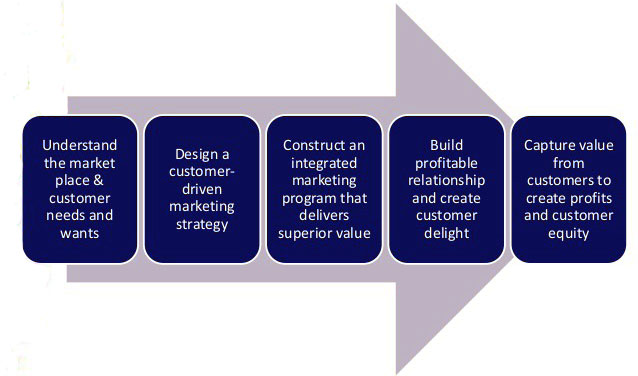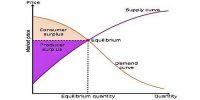Marketing is the process in which advertisers attempt to create profitable relationships with consumers while establishing a profit for their goods or services. In addition to generating new customers, marketers must also focus on customer retention. The marketing process has five key steps that lead to a successful advertising campaign.

Fig: Marketing Process
- Targeting Consumer Wants
The first step of the marketing process is analyzing and comprehending the current marketplace. Understanding what people want is essential to begin a successful marketing campaign. After finding a potential niche for a product or service, marketers must conduct research about competitors and similar items currently available on the market. After identifying these factors, an overall plan must be established to launch the good or service. Sales methods, franchising, and partnerships are all aspects of the product launch that must be examined before production can take place.
- Establishing a Consumer-Driven Sales Strategy
After finding a profitable niche, a unique strategy must be established to market to the intended target audience. This step of the marketing process is essential, as a method must be constructed that not only will be profitable for the company, but also for the consumers. Market segment analysis is often done to break down the population into smaller groups, so the target audience can be found.
- Creating Consumer Value
The next step of the marketing process is finding a way to create a product that offers consumers value for their money. In this step, the four “P’s” of marketing come into play. The first “P” is the product itself; it needs to be something society wants. Additionally, it must be well made and fill a void present in the market. The next “P” in this step of the marketing process is the price of the good or service. Researchers must conduct surveys to establish a price that consumers will pay, without feeling ripped off or cheated. The place is the next “P” that plays a role in marketing. Different venues need different goods or services, so by establishing where the product or service will launch is essential. Finally, promotion methods that accurately represent the good or service to the market need to be laid out.
- Maintaining Consumer Satisfaction
After the product has been officially launched, keeping up consumer satisfaction is essential to the marketing process. In order to expand the current market share of a good or service, new customers must constantly be found. acquired, and convinced to
purchase from you. If the company’s reputation is not maintained properly, it can become increasingly difficult to find additional consumers interested in your good or service. In addition, people that have already purchased from your company must be treated properly. Mistreating this group of people will not only lead to negative publicity but can also harm your chances of having repeat business in the future.
- Creating Profits for the Company
The final step of the marketing process is a culmination of all of the previous steps. When all of the other parts of the process are running smoothly, a company should be operating profitably. If a service is being marketed, customer retention is essential for turning a profit. If consumers believe they are received in value, they will typically remain loyal to your brand, which is extremely valuable in the long run.












